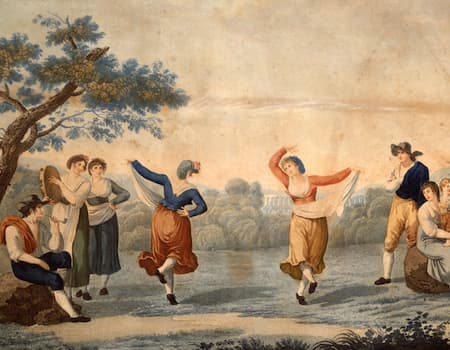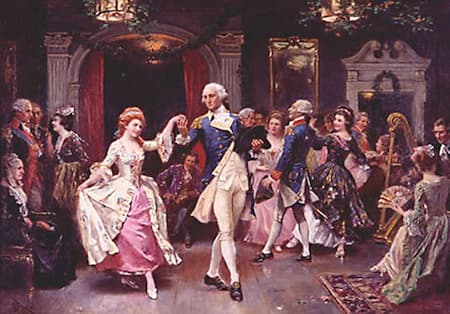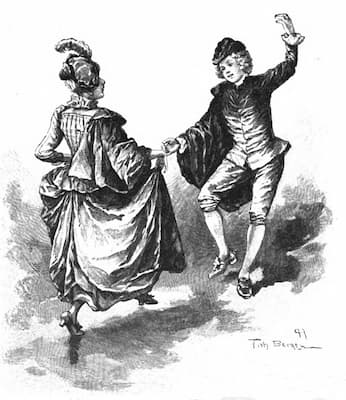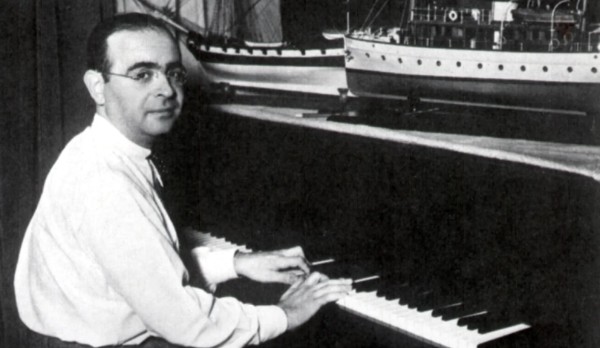The Branle was a group dance, performed by couples in a line or in a circle. The name of the dance comes from the French verb ‘branler’, meaning to shake, sway, or wobble because of the sideways steps. After the necessary 4-beat Révérence, where you greet your partner (right foot forward), you start, with a number of steps sideways to the left, matched with smaller steps to the right, with the net effect that the circle would gradually move to the left.
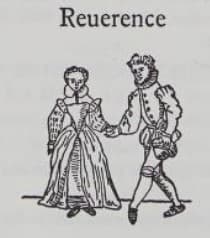
Arbeau: Orchesography the Révérence, 1589
The speed of the music would determine the kind of step the dancers would do, from walking to running, gliding or skipping as the music got faster.
Anonymous: Branle I-IV [Livre de Danse de Paris, 16th century] (Berliner Ensemble fur Alte Musik)
In his 1589 book on social dancing, Orchesography, Thoinot Arbeau gives directions for the branle in both circle and line form. He’s also in favour of slower tempos, saying that they are generally danced better.
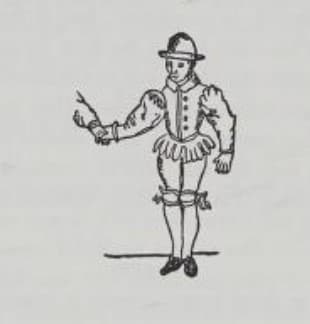
Arbeau: Orchesography the dancer ready for the branle, 1589
After he describes the simple branle (as above, moving to the left and to the right, gradually circling leftward), he describes the ‘gay branle’, which only moves to the left, but, with each step, the moving foot is held in the air. National branles, such as the Burgundian branle are also detailed.

Alfred Dartiguenave: Costumes des Pryénées: Branle d’Ossau, 1855–1856 (Bibliothèque municipale de Toulouse)
The Branle of Haut Barrois involves the whole body in motion: jump with two feet to the left, but land only on the left foot. Next, jump with two feet to the left, landing this time on the right foot. Another jump to the left and land on both feet. Repeat from the beginning and then repeat again, moving to the right.
Anonymous: Suite: – Gaillarde No. 4: Branle de Poitou – Branle commun No. 5: Branle simple – Branle gay No. 6 [published by P. Attaingnant, Paris, 1531] (Glen Wilson, harpsichord)
Arbeau specifies that this branle is ‘danced by lackeys and serving wenches, and sometimes by young men and damsels of gentle birth in a masquerade, disguised as peasants…’. Research shows the branle becoming a court dance by 1558.
Lorenzino del Liuto: Branle (Marco Pesci, lute)
The music was generally in duple time, although the occasional one in triple time can be found. Because of the variety of national branles, it became the fashion at court to string them together in sequence, making the first court dance suites.
Pierre Phalese: Premier Livre de Danseries – Branle de Bourgoigne – Branle de Bourgoigne – Branle 6 – Ungaresca – Saltarello (Getchell, Robert; Capella Sancti Michaelis Vocal Ensemble; Currende Consort)
In the Branle de l’Official, after the moves to the left and right, at the cadence, the ‘men take the women by the waist and assist them to leap into the air and alight upon the said cadence.’
Branle de l’Official
The branle in the modern sense was taken up by composer Carter Pann and he took the English pronunciation of ‘branle’, ‘brawl’, to make a piano dance in 12/8 time that rushes and pauses. The limping, jazzy main melody is undanceable until it’s interrupted by a repeated-note section.
Carter Pann: The Piano’s 12 Sides – V. Le Branle (Joel Hastings, piano)
The branle was a simple dance which made it a convenient vehicle for many different versions – one moved sideways, but with a step? A jump? A jump and then you had your foot in the air for a beat? All of the varieties of improvisation of steps could be applied for a quick round or line dance.
For more of the best in classical music, sign up to our E-Newsletter

